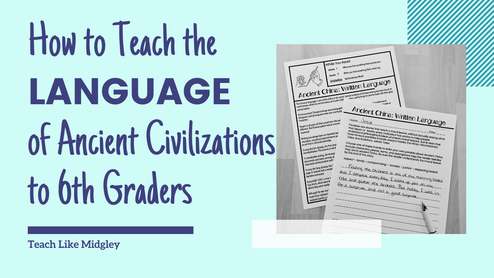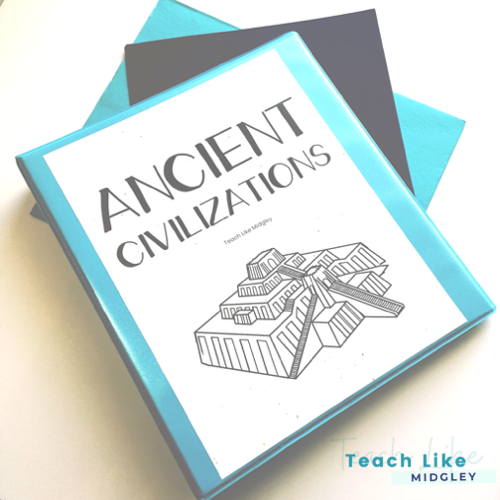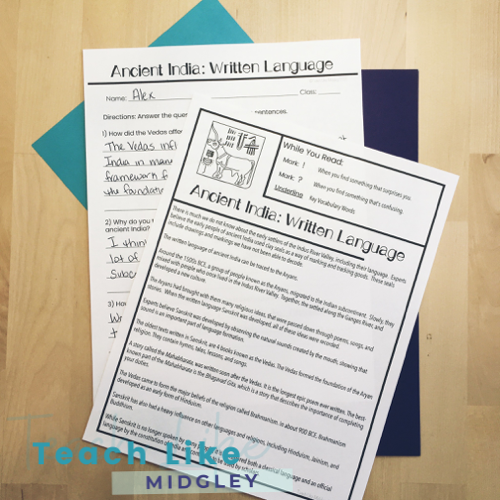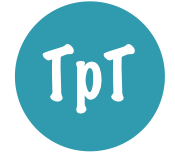How to Teach about the Written Languages of the Ancient World to Sixth Graders
Written language first began in the ancient world, so it makes sense that it would be an important part of the curriculum for our 6th grade social studies class.
Written language is the distinction between prehistory and history. And many would argue that the development of written language is one of mankind’s greatest achievements.
Written language is the distinction between prehistory and history. And many would argue that the development of written language is one of mankind’s greatest achievements.
And yet aside from perhaps a craft or project, the aspect of a written language is often overlooked when planning out lessons for the ancient civilizations.
Ancient written records have provided a great deal of insight to life in many ancient civilizations.
Keep reading this post to discover how you should incorporate teaching written language into your ancient civilization lesson planning for your 6th graders.
The Oldest Languages in the World
Each civilization included with our curriculum has written language as part of their society. The one civilization that does not, would be the Inca. However, they did have an elaborate system of ropes and knots called quipu that were used to keep records. And it’s important to note that the Inca did have a spoken language called Quechuan that is still used in areas of Peru today.
The oldest written languages come from the ancient world.
Evidence shows:
Cuneiform writing began in ancient Mesopotamia around 3200 BCE
Ancient Egyptian writing began around 2690 BCE
Sanskrit writing began in ancient India around 1500 BCE
Ancient Greek writing began around 1450 BCE
Ancient Chinese writing began around 1250 BCE
All of these writings systems were developed by the ancient societies we study as part of our curriculum, and are important to include in our lesson plans.
The oldest written languages come from the ancient world.
Evidence shows:
Cuneiform writing began in ancient Mesopotamia around 3200 BCE
Ancient Egyptian writing began around 2690 BCE
Sanskrit writing began in ancient India around 1500 BCE
Ancient Greek writing began around 1450 BCE
Ancient Chinese writing began around 1250 BCE
All of these writings systems were developed by the ancient societies we study as part of our curriculum, and are important to include in our lesson plans.
Core Content
To start, you will want to present core content to your students on the civilization you are currently studying. This could come in many different forms: textbook, supplemental readings, learning magazines, online resource, etc.
Most curriculums will focus on the four main river valley civilizations: Mesopotamia, Egypt, India and China. All four of these societies have a written language worthy of studying.
Some societies, such as the Greeks, developed their alphabet by building on the ideas of others. The Greek alphabet is based on the Etruscan and Phoenician alphabets.
There are also lesser known languages such as the Aramaic language that became the foundation for the Hebrew and Arabic alphabets. Which should be included if your curriculum incorporates the ancient Israelites (Hebrews).
If you’ve been around here for a while, then you know that when I started teaching sixth grade, I had little to no resources available to me. This experience has been my motivation and driving force behind writing this blog and creating ready-to-roll resources for teachers like you. Each of my Ancient Civilization Lesson Sets comes with a reading passage and a PowerPoint presentation to help you provide core content to your students.
You will also want to make sure you identify key vocabulary terms that students should know to help them further their understanding.
Some societies, such as the Greeks, developed their alphabet by building on the ideas of others. The Greek alphabet is based on the Etruscan and Phoenician alphabets.
There are also lesser known languages such as the Aramaic language that became the foundation for the Hebrew and Arabic alphabets. Which should be included if your curriculum incorporates the ancient Israelites (Hebrews).
If you’ve been around here for a while, then you know that when I started teaching sixth grade, I had little to no resources available to me. This experience has been my motivation and driving force behind writing this blog and creating ready-to-roll resources for teachers like you. Each of my Ancient Civilization Lesson Sets comes with a reading passage and a PowerPoint presentation to help you provide core content to your students.
You will also want to make sure you identify key vocabulary terms that students should know to help them further their understanding.
Student Processing Activities
After students have been presented with the core content, next they need the opportunity to process and work with the new information. Writing summaries, completing diagrams or charts, manipulating material in different activities or a worksheet that reinforces key concepts are all excellent choices.
Answering questions using a chart of different languages, complete with questions that encourage students to make inferences about the impact of language on the society’s economic success, is always a good choice.
Another great way to have students work with new content is to have them complete an activity in their interactive notebook with a foldable activity or exercise.
Each of my Ancient Civilization Lesson Sets comes with a worksheet and an activity. While the worksheets are intended to reinforce key concepts, the activities are designed to help your students take the material one step further in their level of thinking.
Answering questions using a chart of different languages, complete with questions that encourage students to make inferences about the impact of language on the society’s economic success, is always a good choice.
Another great way to have students work with new content is to have them complete an activity in their interactive notebook with a foldable activity or exercise.
Each of my Ancient Civilization Lesson Sets comes with a worksheet and an activity. While the worksheets are intended to reinforce key concepts, the activities are designed to help your students take the material one step further in their level of thinking.
Reinforce Key Concepts
The final step to teaching about the written language of ancient civilizations is to CONSTANTLY revisit and reinforce key concepts.
Every day, every lesson starts the same way, with a brief review of what we’ve already studied. Sometimes this looks like rapid fire questioning while I collect homework. Other days it’s a brief summary.
But it also includes going back and asking students to recall information during new lessons. Especially when we learn about achievements or literature contributions, we are talking about what we already know in terms of written language.
You may find your students are struggling to remember certain things, this is a flag for you, that they need more practice with the content. Maybe some extra vocabulary work may benefit.
As you progress in your lessons, you also want to help your students take their thinking to the next level and utilize advanced questioning. For each Lesson Set, I developed a set of 5 Questions that follow the lines of Bloom’s Taxonomy Questioning Techniques.
Every day, every lesson starts the same way, with a brief review of what we’ve already studied. Sometimes this looks like rapid fire questioning while I collect homework. Other days it’s a brief summary.
But it also includes going back and asking students to recall information during new lessons. Especially when we learn about achievements or literature contributions, we are talking about what we already know in terms of written language.
You may find your students are struggling to remember certain things, this is a flag for you, that they need more practice with the content. Maybe some extra vocabulary work may benefit.
As you progress in your lessons, you also want to help your students take their thinking to the next level and utilize advanced questioning. For each Lesson Set, I developed a set of 5 Questions that follow the lines of Bloom’s Taxonomy Questioning Techniques.
Ready to Roll Materials
Now you know exactly how I teach about the written language of ancient civilization to my sixth graders and you are ready to do the same!
But if you are struggling to find the materials you need – well, you know I’ve got you covered! No matter which unit you are about to teach, check out my TpT Store for all the Lesson Sets designed to help you teach about Written Language!
But if you are struggling to find the materials you need – well, you know I’ve got you covered! No matter which unit you are about to teach, check out my TpT Store for all the Lesson Sets designed to help you teach about Written Language!
You May Also Like...

Welcome! I'm Hillary Midgley, a veteran 6th grade teacher.
I create educational materials and develop curriculum for other teachers. I specialize in teaching students how to learn through my Study Skills Curriculum. I have established fundamental classroom systems and structures for teachers to help them streamline their classroom. And my passion is teaching ancient history through engaging activities with foundations in academic skills. Here you will find resources on all of these topics and more. Learn more about me here.
|











